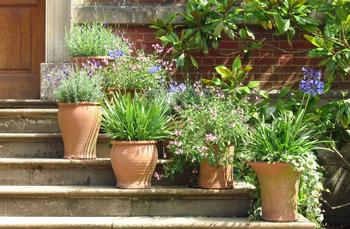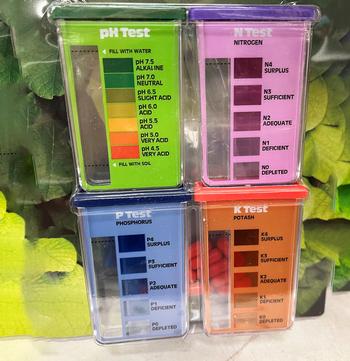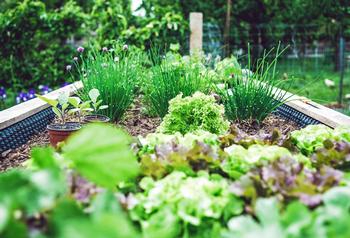Food for thought about fertilizing
-
Nanette Londeree
-
We gardeners routinely describe fertilizing as “feeding” our plants, but that’s not accurate—plants “feed” themselves, producing their own food in the form of sugars through photosynthesis. We add nutrients, the chemical elements necessary for plant growth, to supplement those naturally occurring in the soil. Consider Mother Nature’s process in a forest - through lots of biological activity, fallen leaves, and dead plants slowly decay, and their nutrients are worked back into the soil to be taken up by living plants. By fertilizing, we’re doing the same thing - making nutrients available to the plant via the soil.
 You may need to fertilize plants growing in containers more frequently as regular watering can leach nutrients from the soil over time. Photo: PxHere
You may need to fertilize plants growing in containers more frequently as regular watering can leach nutrients from the soil over time. Photo: PxHereIt takes tremendous energy for plants to flower and produces fruit and seeds while developing a healthy root system and growing leaves for photosynthesis. Rapidly growing plants like annual vegetable crops generally need more nutrients than slow-growing plants like established perennials. Fertilizing provides nutrients essential for optimum plant growth when required and helps replenish lost soil nutrients.
Rather than fertilizing based on the calendar, consider trying an Earth-friendly approach: Fertilizing Test your soil at home with simple colorimetric kits to determine what you may need to add to the soil. Photo: Nanette Londeree
Fertilizing Test your soil at home with simple colorimetric kits to determine what you may need to add to the soil. Photo: Nanette Londeree- Know what your plant needs: Different plant types have varying nutrient needs. The ability of the soil to supply those nutrients varies by location, season, and weather conditions. Many woody ornamentals, such as non-flowering trees, shrubs, and native plants, don’t require fertilizer, even at planting.
- Add just what’s needed: Most of the 18 chemical elements plants need for healthy growth are already in the soil or the air and don’t need to be added regularly. Test your soil for the big three - nitrogen, phosphorus, and potassium (N-P-K), then add only the nutrients that the soil test results indicate are lacking. Also, check soil pH. Many nutrients become unavailable or overly abundant outside a pH range of 6.0 to 7.0.
- Incorporate organic matter: Not only does organic matter improve the structure of the soil, but it also adds essential nutrients for plants, such as nitrogen, phosphorus, and sulfur, as microbes are decomposing it. It also feeds and provides habitats for diverse soil organisms, including those that help fight plant pests and diseases.
- More is not better: Too much fertilizer, whether applied too often, too much in a single application or added at the wrong time, can burn or desiccate roots. It can stimulate excessive plant growth that attracts pests and increase the amount of water a plant needs.
- Please keep it in your garden: Surplus fertilizer can end up running off in storm drains, ultimately making its way into bodies of water like the bay, where it can have a negative impact on fish and other aquatic animals. Use organic materials or slow-release fertilizers and incorporate them into the soil. Turn off irrigation when the soil is no longer absorbing water to prevent runoff. Opt for natural fertilizers if you need to provide specific nutrients to your soil. Often sold as meals, these agricultural and farming by-products release nutrients slowly over a longer period, allowing plants to absorb them more efficiently. Compost, with a relatively low N-P-K ratio, does double duty, improving soil quality and providing nutrients.
Some other handy fertilizing tips: Fast-growing plants, like annual vegetables, use soil nutrients more quickly than plants that grow more slowly. Photo: Markus Spiske, Unsplash
Fast-growing plants, like annual vegetables, use soil nutrients more quickly than plants that grow more slowly. Photo: Markus Spiske, Unsplash- Don't fertilize drought-stressed plants; be sure the soil around the roots is completely moist.
- Fertilizing in late summer and early fall can encourage tender late growth that is easily killed in winter.
- Pass up those specialized products for roses, citrus, azaleas, and more. Purchase products based on what they contain, the N-P-K concentrations, and any other additives.
- Avoid multi-purpose products that contain a mixture of fertilizer, insecticide, fungicide, or similar weed and feed lawn products. Using combination types of fertilizer products when there is no specific insect pest, disease, or weeds present adds pesticides to the soil for no purpose. It can negatively impact soil organisms, bees, and other pollinators and is much more expensive than single-use products.



